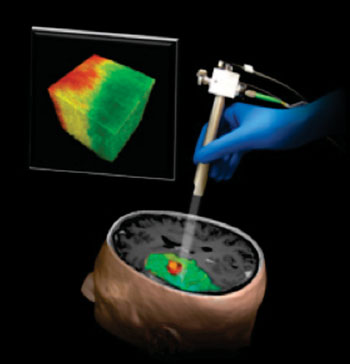Imaging Technique Helps Safer and More Effective Removal of Brain Tumors
By MedImaging International staff writers
Posted on 15 Jul 2015
Researchers at the Johns Hopkins University have demonstrated a new imaging technology that could enable neurosurgeons to better differentiate between healthy and cancerous brain tissue and perform safer and more effective neurosurgery procedures.Posted on 15 Jul 2015
The technology, called Optical Coherence Tomography (OCT), uses visible light echolocation imaging to create higher-resolution images than is possible with ultrasound. OCT produces a color-coded map of a patient’s brain that shows which areas are and which are not cancer. Unlike X-ray, Computed Tomography (CT) scans or Positron Emission Tomography (PET) scans, OCT is safer for patients because it has no ionizing radiation.

Image: Illustration of a new technique using Optical Coherence Tomography that could help surgeons differentiate a human brain tumor, red, from surrounding noncancerous tissue, green (Photo courtesy of Carmen Kut, Jordina Rincon-Torroella, Xingde Li and Alfredo Quinones-Hinojosa/Johns Hopkins Medicine).
A summary of the research was published in the June, 17, 2015 issue of the journal Science Translational Medicine. The researchers discovered that cancer cells in the brain lack the myelin sheaths found in healthy brain cells. The researchers used the characteristic OCT “signature” of brain tumors and developed a computer algorithm that could process that data automatically and generate a color-coded map with cancerous tissue in red, and healthy areas in green.
The researchers conducted the research using human brain tissue, and mice, and plan to begin human clinical trials in Summer 2015.
If successful, OCT would be a significant step forward in brain cancer imaging, and could provide live feedback from the area being operated on, showing where the cancer is located. In comparison, ultrasound has a much lower resolution, and Magnetic Resonance Imaging (MRI) scanners are more expensive, bulky, and take longer to operate.
The system could also potentially be adapted to detect cancers in other parts of the body, for example to help surgeons visualize and avoid damaging vulnerable blood vessels during surgery.
Alfredo Quinones-Hinojosa, MD, a professor of neurosurgery, neuroscience and oncology at the Johns Hopkins University School of Medicine (Baltimore, MD, USA), clinical leader of the research team, said, “As a neurosurgeon, I’m in agony when I’m taking out a tumor. If I take out too little, the cancer could come back; too much, and the patient can be permanently disabled. We think optical coherence tomography has strong potential for helping surgeons know exactly where to cut.”
Related Links:
John Hopkins School of Medicine








 Guided Devices.jpg)





